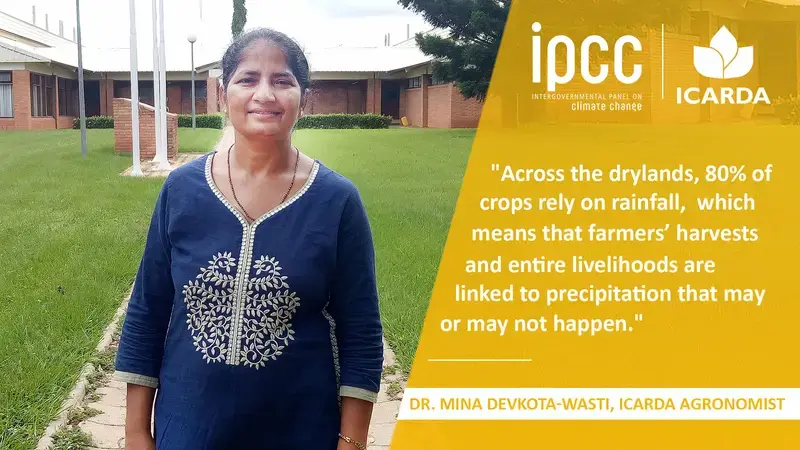AGRONOMIST DR. MINA DEVKOTA DISCUSSES DRYLANDS AND THE IPCC REPORT

In a mini-Q&A series published this week and the next, ICARDA scientists express their views on what the future of climate change might look like across the drylands, and explain how ICARDA is helping dryland family farmers adapt.
Today’s Q&A features Dr. Mina Devkota-Wasti, an agronomist at ICARDA with a decade of experience in soil science in South Asia, the Middle East and North Africa region, and in the irrigated drylands of Central Asia.
---------
Dr. Mina Devkota-Wasti: I'm concerned about the contributions of the commercial agricultural sector to climate change emissions, particularly methane from livestock and nitrous oxide emissions from chemical pesticides and fertilizers.
This report shows how urgent it is to rein in those emissions in all sectors, including commercial agriculture, and urges policymakers to come up with sustainable solutions to radically change course.
MDW: Most of my experience as an agronomist has taken me to North Africa and South and Central Asia. Across the drylands, climate change is evidenced by the frequency of extreme weather events, which put agriculture production at high risk.
Erratic weather conditions weaken farmers’ ability to make important decisions on crops, irrigation, and fertilizers. Upon analyzing the long-term rainfall data in Morocco, I have noticed that the rainfall follows a different pattern every year. Drought, flash floods, and heatwaves can occur at any time during the crop growing cycle.
Across the drylands, 80% of crops rely on rainfall, which means that farmers’ harvests and entire livelihoods are linked to precipitation that may or may not happen. Climate change is also giving rise to new pests and diseases, which further threaten farmers’ income.
Long droughts also mean dwindling forages to feed the animals, and rising feed prices. In the region, we have observed more instances of conflicts between pastoralists and farmers over food and water supplies for animals during droughts.
MDW: Because it is ICARDA’s mandate to improve food security and farmers’ livelihoods in the drylands, we use our diverse set of expertise to develop innovations able to address the present and future impact of climate change.
Plant breeders identify the most resilient and high-yielding varieties able to grow in resource-poor environments, while agronomists, soil and water scientists develop package of practices associated with these sturdier varieties.
In some water-stressed areas, ICARDA experts can recommend that farmers swap water-thirsty cereal crops for alternatives with lower water requirements.
To guarantee food security in rainfed drylands, we also work on supplementary irrigation, and optimize water supplies through better management, water harvesting in the wet season for use in the dry season, and deploy efficient systems such as solar-powered drip irrigation.
We also promote diversified cropping systems to create better rural livelihoods, and diets. Because crops and livestock are equally valuable in dryland farming systems, we do a lot of work to improve the integration between the two, to minimize competition over food, land, and water resources.
We are also conducting experimental work to improve fodder quality, such as cereal and legume mixtures for more nutritious forages.
Soil in the drylands is very degraded, and in a much worse state than in almost any other region. Across the Middle East and North Africa, soil is degrading fast, particularly in cultivated areas.
This is the result of continuous cereal monocropping, practiced by 80% of dryland farmers. Intensive soil disturbance, crop residue removal, poor rotation systems and animal grazing are all contributing to the breakdown of soil health, which is one of the main limitations to reliable food supplies in the region. This leads to soil erosion, and poor carbon input.
To cope with this challenge, we work with farmers and extension officers to promote conservation agriculture practices that improve soil health and resilience to adverse climatic condition. We generate package of conservation agriculture practices aligned with the biophysical and socio-economic contexts.
We also work on developing crop varieties and management practices that can sequester more carbon in the soil. In addition, with better crop choices and improved management practices, we are intensifying cropping systems, thereby enabling farmers to grow two crops per year instead of one, with added benefits to the soil.
Finally, we work on finding alternative livestock feed solutions that would maintain mulch-like crop residues on the soil, to improve its carbon content.
This is crucial work, because a healthy soil is by far the best coping mechanism any farmer can have.
